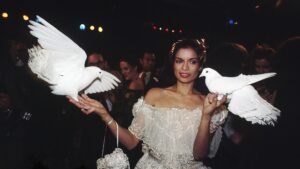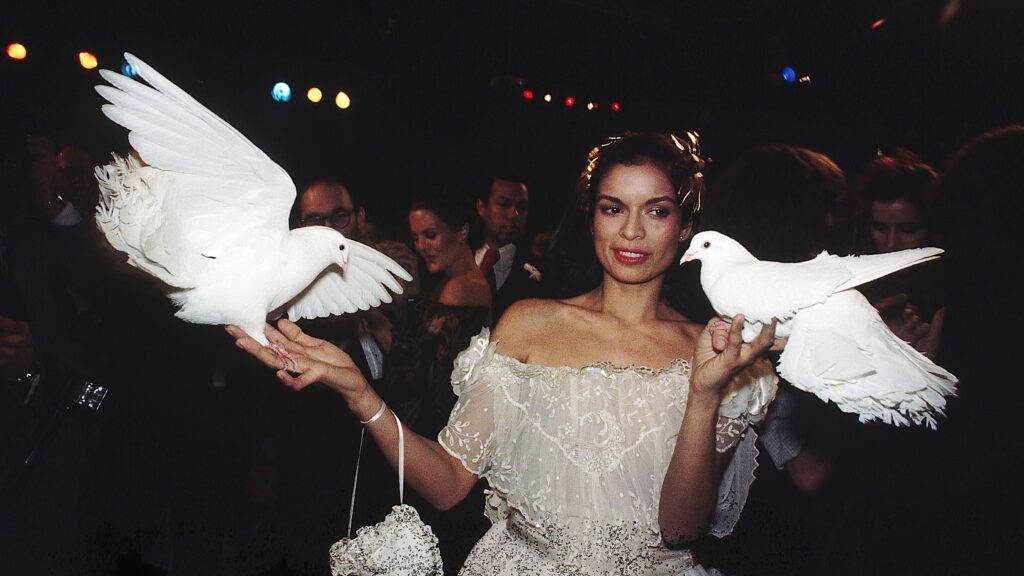Looking back to the past, to the vibrant 70s, the bustling dance floor that gathered numerous Hollywood celebrities – Studio 54 is undoubtedly a reliable reference for fashion enthusiasts gearing up to perfect their holiday looks.

Summary: Illuminate the runway with eye-catching bodysuits Elegantly embodying the “Queen of party” standard with suits Stand out from the crowd with glamorous evening gowns Timelessly chic with jeans Long before the Met Gala became the world’s most exclusive superstar feast, or the most luxurious fashion halls in history, that throne belonged to Studio 54 – a notorious nightclub frequented by countless celebrities worldwide. Before closing its doors in the mid-1980s, Studio 54 was not just a place for revelry and dancing; it was considered one of the “fashion sanctuaries” in the late 70s and early 80s. Regardless of the club’s controversial issues, no one can deny Studio 54’s profound and special influence on fashion. This is still evident today in the creative reigns at Celine and Saint Laurent. Like the rules set for Met Gala attendees, not everyone could step foot into Studio 54 unless you were Andy Warhol, Mick and Bianca Jagger, Grace Jones, Liza Minnelli, Elizabeth Taylor, or other cultural icons of the time. However, once inside, “everyone was free to do as they pleased.”
Studio 54 has created a legacy far beyond its original business purposes, and it’s fair to say that to this day, no club has matched Studio 54’s influence. The impact of this legendary nightclub extends not only to the fashion world but also to film and art. Many documentaries and feature films on the big screen have recounted the ups and downs of Studio 54. The nightclub’s origins date back to 1927 when it was initially opened as the Gallo Opera House by American-Italian architect Eugene De Rosa. While Gallo was initially designed to be a dance venue for hosting the most exciting events, by the early 1930s, the building was being used as a nightclub, then called the Casino de Paree.
In the 1940s, it reverted to its true essence, serving as a stage for the New Yorker Theatre. Fast forward to 1976, when a German model named Uva Harden appeared and made history. With the desire to establish a nightclub in New York City, Harden and business partner Yoram Polany agreed to take over CBS Studio, hence the name Studio 54 (due to its location on 54th Street in Midtown Manhattan). Studio 54’s goal was to provide a new and exciting entertainment experience, promising to open up a different kind of relaxation space. In addition to the lively disco dance floor, magnificent sound system, and beautiful swimming pool, Studio 54 was continuously updated with special effects systems such as paper flowers, fog, snow, or various creative interior designs.
Studio 54 opened at the height of the disco era. Its influence was so strong that many believed “Studio 54 was simply a straightforward term for disco.” From the visionary Uva Harden to subsequent owners Steve Rubell and Ian Schrager, along with the attendance of famous stars, they all ushered in a new era, an era where gender flexibility was freely expressed, a statement of social politics, and a stage for everyone to live authentically and become a star overnight. Therefore, at that time, Studio 54 was always a bustling place that piqued the curiosity of every famous star. During Studio’s golden years (from 1977 to 1981), the nightclub attracted thousands of stars from models, actors, rock music stars, artists, fashion designers, politicians, to some famous ballet dancers. From Diana Ross DJing to Bianca Jagger riding in on a white horse; from Mick Jagger’s tousled curls and Farrah Fawcett’s curls to Donna Summer’s disco curls, to the wild eyebrows and bangs of Elton John; from Grace Jones’s quirky hats to the moment Pat Cleveland twirls on the dance floor,… all are deeply ingrained moments in countless generations, leaving golden milestones in fashion and art history.
Although Studio 54 has closed, the disco dance floor is gone, but the fashion scene in the nightclub has always been a legend, a reliable source of inspiration for every party and holiday season. Many decades later, the lasting impact of 70s fashion and Studio 54 still exists and persists in contemporary wardrobes with high-waisted jeans and overalls, deep V-neckline details, sparkling sequin fabrics, billions of velvet bodysuits, glamorous flowing evening gowns with dizzying slits, super short shorts, distinctive layering jewelry, bold platform high heels,… Even though only preserved in black and white or faded images, the golden scenes, and the wildness at Studio 54 still make the fashion world long to travel back to the past to live in that vibrant moment once in a lifetime. With the holiday season approaching, the “fashion dance floor” of Studio 54 is certainly a reliable mood board for your upcoming party wardrobe:
Illuminate the runway with eye-catching bodysuits In the 70s, bodysuits were a powerful weapon for women and they were the uniform of the “fashion party” at Studio 54. From transparent designs that revealed flesh, sparkling with crystal rhinestones, made from athletic materials, to dazzling sequins, Studio 54 brought a range of unique studio-style designs, suitable for the fashion standards of that era and even today. In addition to swimsuit-style bodysuits, women could also wear more modest designs with sleeves and long pants, both trendy and safe for nightclub wear. With short, snug bodysuit designs, ladies could mix and match with outer blazers or wear tights underneath for added confidence. Women could experiment with various designs combining different materials like feather and sheer mesh like Cher, or daring plunging necklines like Grace Jones.
Elegantly embodying the “Queen of party” standard with suits In the 70s, amidst societal chaos, an era of emerging subcultures and numerous revolutions changing outdated standards, such as gender and women’s rights. Alongside seductive, feminine dresses, suits, originally reserved for men, were confidently worn by women at Studio 54 and every corner of the street. With glossy, comfortable satin fabrics, well-tailored suits not only made the wearer more elegant but also comfortable for every dance move. With broad, square shoulders, women’s suits at that time were also stylized with smooth waistlines and flared trouser legs. At lively parties, women preferred to wear suits with breast-paneling to create a sexy V-neckline detail or oversized silhouettes. Women could also challenge themselves with various suitable materials for the party spirit like sequins or combined with feathers.
Stand out from the crowd with glamorous evening gowns Short cocktail dresses with open backs were always a familiar face at every party, especially at Studio 54. However, alongside those timeless designs, the Studio 54 dance floor also gathered glamorous evening gowns, sweeping the floor and standing out with dramatic details. The fashion world surely cannot forget how Bianca Jagger stole the spotlight (as always) with an elegantly off-shoulder gown, praising the extravagance of the era; or how Cher transformed cut-out evening gowns into timeless


